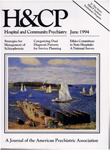Defining Subgroups of Dual Diagnosis Patients for Service Planning
Abstract
The high proportion of persons presenting for treatment of psychiatric disorders who also have comorbid substance use problems severely challenges the capacity of mental health care programs to plan for patients' needs. One of the problems encountered in anticipating the treatment needs of these patients is the wide beterogeneity of their comorbidity, that is, the broadly varying types, severity, and time courses of psychiatric and substance disorders. This paper describes and evaluates a relatively simple conceptual framework for delineating the beterogencity of patients who are dually diagnosed. Methods: A typology of subgroups of patients was defined a priori based on whether patients are singly or dually diagnosed and whether their disorders are current or past. Patients admitted to three treatment facilities in an inner-city catchment area were assigned to one of the subgroups based on administration of the Structured Clinical interview for DSM-III-R-Patient Version (SCID-P). The subgroups were compared on clinical diagnoses and service needs as measured by the SCID-P and the Addiction Severity index. Results: A total of 461 patients were assigned to four mutually exclusive dual diagnosis subgroups-patients with current definite dual diagnoses, current possible dual diagnoses, current substance-induced organic mental disorder, and past definite dual diagnoses—and the two comparison groups. The subgroups differed significantly from each other and from two single-diagnosis comparison groups on axis i diagnoses, types of substance use disorders, and current problem areas. Conclusions: The framework developed has potential utility for distinguishing subgroups of dually diagnosed patients relevant for service planning.
Access content
To read the fulltext, please use one of the options below to sign in or purchase access.- Personal login
- Institutional Login
- Sign in via OpenAthens
- Register for access
-
Please login/register if you wish to pair your device and check access availability.
Not a subscriber?
PsychiatryOnline subscription options offer access to the DSM-5 library, books, journals, CME, and patient resources. This all-in-one virtual library provides psychiatrists and mental health professionals with key resources for diagnosis, treatment, research, and professional development.
Need more help? PsychiatryOnline Customer Service may be reached by emailing [email protected] or by calling 800-368-5777 (in the U.S.) or 703-907-7322 (outside the U.S.).



